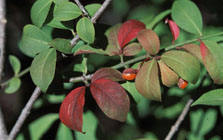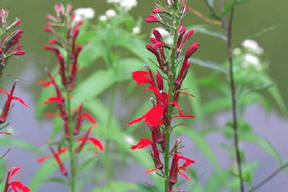 This August my family and I traveled to Southern Maine and spent a week along the coastline. The coastal waters would break against rocks, boulder, cliffs and very
little sand. Only a few miles inland, we hiked through woodlands that resembled ours here in Pennsylvania...
This August my family and I traveled to Southern Maine and spent a week along the coastline. The coastal waters would break against rocks, boulder, cliffs and very
little sand. Only a few miles inland, we hiked through woodlands that resembled ours here in Pennsylvania...
The coastline was beautiful. The kids enjoyed climbing on the rocks and exploring the life forms in the tidal pools. We walked along a path, called Marginal Way that stretched along the coastline. The girls enjoyed the coastal habitat, as my husband and I observed the
different plant and animal life living there. Northern bayberry was plentiful, as well as blueberries and a wildflower that resembled goldenrod.
I'm sharing this to state the importance of preserving our own natural habitat here in Adams County. The habitat in Southern Maine, even though there were many similarities, also introduced us to many differences. Knowing our native plants and preserving them by using
native plants in our own "habitats" would be a very good first step in helping our native plants survive and thrive in South Central Pennsylvania.
As so much development takes place in Adams County, it becomes even more important for us to use native plant materials in our own yards whenever possible. Now that we are entering into the fall planting season, consider using our natives when designing your landscapes and
purchasing plants. For instance, using a fringe tree at the corner of your house instead of a crabapple may be an option. A fringe tree will become 25 - 30' and grow to be just about as round. Pretty, dainty white flowers dangle from the tree in early June. It's not only a
beautiful tree when it blooms, but it produces a wonderful fragrance as well. Another tree you may want to consider is a serviceberry. Often grown in clump forms, it can also be purchased as a single stemmed tree. It has white flowers, but blooms earlier that the fringe
tree, in May. It produces berries that the birds will enjoy. This tree will reach a height of 25'.
Another plant you may want to consider is the fothergilla. This plant is a small flowering shrub and could replace a spirea or dwarf weigela in the landscape. It would make a nice foundation plant as it reaches about 3 - 4' , depending on the cultivar. This plant gets a
bottlebrush flower in early - mid April, and presents a terrific fall show, turning shades of orange and red.
|

Burning Bush
Euonymus alata
|
There are several native viburnums that can be used in the shrub border, replacing plants like burning bush. You may also want to use it individually as a specimen plant.
Inkberry holly is a broadleaf evergreen that can replace plants like boxwood or even junipers. This plant maintains a medium green evergreen foliage, and has little insect and disease problems. It will reach 3 - 5' and will become just as wide.
Many perennials are also native to our area. For instance, coral bells, columbine and cardinal flower are just a few.
|

Lobelia cardinalis - (Cardinal Flower)
|
Visit the Agricultural and Natural Resource Center to see some of these natives and others used successfully in the foundation planting. All plants are named for your convenience, and information sheets on the plants are available.
When walking in the forests, meadows, and fields in our own beautiful Adams County, take a closer look at the plant life growing there. Enjoy the uniqueness of our county as well as other counties you visit in your daily travels. I know my family enjoyed the distinctiveness
of the Maine coastline, but we also enjoy the beauty we are fortunate to experience every day in our own "habitat. Let's not loose this beauty, but do everything we can to preserve it!
Read other articles on ecological gardening & native plants
Read more Articles by Mary Ann Ryan